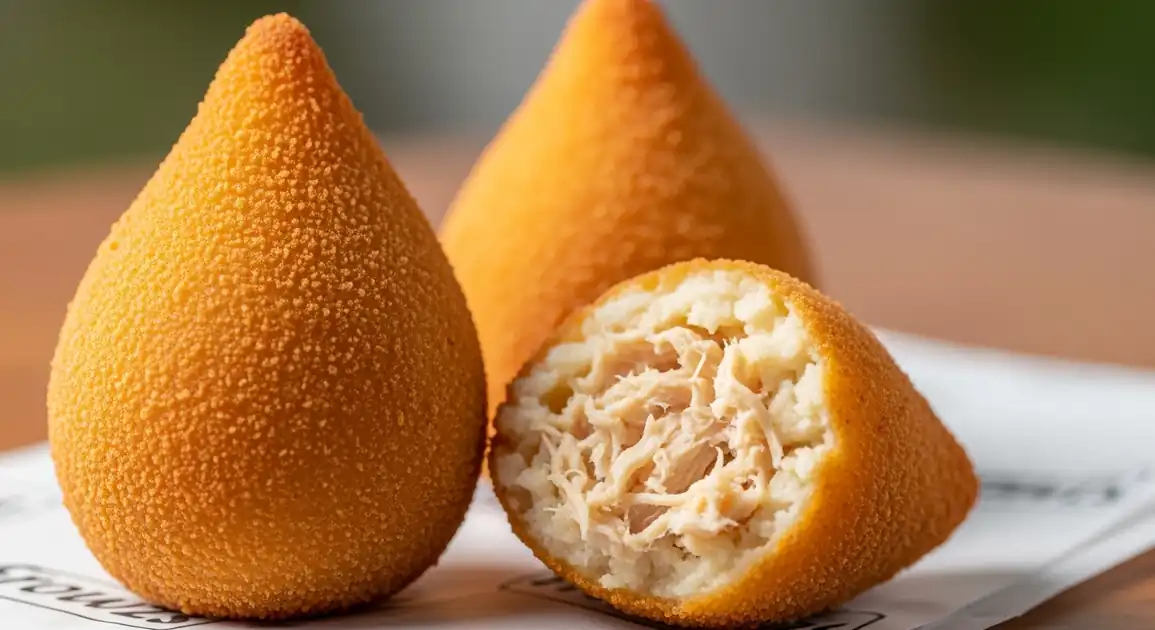Coxinha (Brazilian Chicken Croquette)
Coxinha

Description
Coxinha is a national passion in Brazil, available virtually everywhere, from bustling city bakeries ('padarias') and snack bars ('lanchonetes') to humble street carts and sophisticated cafes. While originating likely in São Paulo state, it's beloved nationwide as a go-to snack or appetizer.
Dietary Information
Serving information
Serving style
Served hot/warm, usually on a small plate or napkin. Eaten by hand. Often accompanied by optional hot sauce ('molho de pimenta').
Quick facts
Padarias often open early (6 AM) and close late (8 PM - 10 PM). Lanchonetes have varied hours, often 10 AM - 10 PM. Botecos mainly afternoon/evening. Street vendors vary greatly.
Safety Tips
What to Look For
-
Coxinha fried fresh ('frito na hora') or kept very hot
Ensures the snack is cooked thoroughly and minimizes risk from being held at unsafe temperatures. Fresh frying yields the best crispy texture.
-
Golden-brown, intact crust
Indicates proper frying temperature and technique. Avoid coxinhas that are pale (undercooked) or cracked/leaking.
-
Clean vendor environment (lanchonete, padaria, cart)
General cleanliness of the counter, display case, and vendor handling practices are good indicators of overall hygiene.
-
Busy establishment with high turnover
Suggests ingredients and batches are likely to be fresher.
-
Hot, relatively clean frying oil
Avoid places using extremely dark, old, or smoking oil, which impacts flavor and safety.
What to avoid
-
Coxinhas sitting under a heat lamp for a long time
Quality degrades rapidly (becomes soggy or dry), and holding food at lukewarm temperatures increases food safety risks.
-
Pale, undercooked-looking coxinhas
May not be cooked through properly.
-
Coxinhas that are broken, leaking filling, or look collapsed
Could indicate poor preparation or that they are old.
-
Excessively greasy coxinhas
Suggests frying oil might not have been hot enough.
-
Vendors with visibly poor hygiene practices
Increases the risk of contamination.
Price information
Price range
Budget tips
- Prices are generally very affordable, making it a staple snack.
- Neighborhood padarias and lanchonetes usually offer the best prices.
- Prices in major tourist areas or airports might be higher.
- Mini coxinhas are often sold by weight or per 100 units for parties.
Value indicators
- Crispy, golden-brown crust.
- Generous amount of flavorful, moist filling.
- Served hot and fresh.
- Good dough-to-filling ratio (not too thick).
Where to Find This Dish
Padarias (Bakeries)
Ubiquitous neighborhood bakeries almost always have a savory snack counter featuring coxinhas.
Nearly every neighborhood
Morning, Afternoon
Lanchonetes (Snack Bars)
Casual eateries specializing in sandwiches, juices, and fried snacks ('salgados').
Commercial streets, Near bus stops
All day
Botecos (Local Bars)
Traditional bars serving beer and appetizers ('petiscos'), including coxinhas.
Neighborhood corners
Evening, Late Afternoon
Street Vendors
Carts selling various salgados, common in busy pedestrian areas.
Busy sidewalks, Near stations, Events
Lunchtime, Afternoon
Vendor Tips
- Ask 'Está quentinha?' (Is it warm/hot?) before buying.
- Don't miss trying the version 'com Catupiry' if available.
- Look where locals are buying; it's usually a good sign.
How to Order
Regional Variations
-
Coxinha de Frango
(Coxinha de Frango)
The classic version filled with seasoned shredded chicken.
-
Coxinha com Catupiry
(Coxinha com Catupiry)
A hugely popular variation where Catupiry brand cream cheese is added to the chicken filling.
-
Coxinha de Palmito
(Coxinha de Palmito)
A common vegetarian version filled with hearts of palm.
-
Coxinha de Carne Seca
(Coxinha de Carne Seca)
Filled with seasoned 'carne seca' (Brazilian dried/jerked beef).
-
Coxinha de Camarão
(Coxinha de Camarão)
Filled with seasoned shrimp, more common in coastal areas or specialty shops.
-
Mini Coxinhas
(Mini Coxinhas / Coxinha de Festa)
Smaller, bite-sized versions often served at parties ('festas') or sold by the dozen.
-
Vegetarian/Vegan Coxinhas
(Coxinha Vegetariana/Vegana)
Modern variations using fillings like seasoned soy protein, mushrooms, spinach, or other vegetables, often found in specialized cafes.
Cultural context
History
While various origin stories exist, including legends involving Brazilian royalty requesting a chicken thigh when none were available, the modern coxinha likely developed in São Paulo state during the period of industrialization in the late 19th or early 20th century. It became a way to utilize unsold chicken parts, transforming them into a delicious and affordable snack. Its popularity spread rapidly, making it one of Brazil's most iconic and consumed savory pastries.
Local significance
An icon of Brazilian popular cuisine and comfort food. Represents affordable, accessible deliciousness and is part of the daily routine for many Brazilians.
Eating customs
- Eaten casually, often standing at the counter.
- Applying hot sauce is very common.
- Consumed quickly as a snack or ordered as part of a selection of 'salgados'.